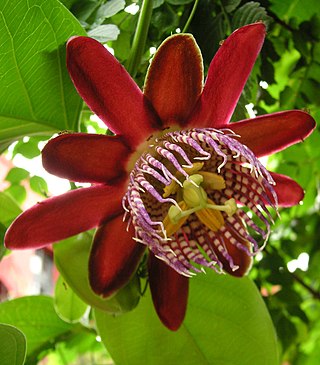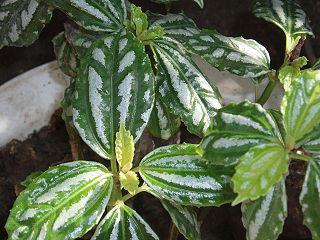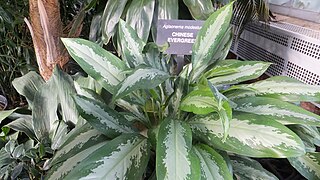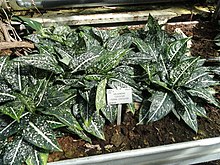
Freesia is a genus of herbaceous perennial flowering plants in the family Iridaceae, first described as a genus in 1866 by Christian Friedrich Ecklon (1886) and named after the German botanist and medical practitioner, Friedrich Freese (1795-1876). It is native to the eastern side of southern Africa, from Kenya south to South Africa, most species being found in Cape Provinces. Species of the former genus Anomatheca are now included in Freesia. The plants commonly known as "freesias", with fragrant funnel-shaped flowers, are cultivated hybrids of a number of Freesia species. Some other species are also grown as ornamental plants.

Alstroemeria, commonly called the Peruvian lily or lily of the Incas, is a genus of flowering plants in the family Alstroemeriaceae. They are all native to South America, although some have become naturalized in the United States, Mexico, Australia, New Zealand, Madeira and the Canary Islands. Almost all of the species are restricted to one of two distinct centers of diversity; one in central Chile, the other in eastern Brazil. Species of Alstroemeria from Chile are winter-growing plants, while those of Brazil are summer growing. All are long-lived perennials except A. graminea, a diminutive annual from the Atacama Desert of Chile.

Pulmonaria (lungwort) is a genus of flowering plants in the family Boraginaceae, native to Europe and western Asia, with one species east to central Asia. According to various estimates there may be between 10 and 18 species found in the wild.

Clivia miniata, the Natal lily or bush lily, is a species of flowering plant in the genus Clivia of the family Amaryllidaceae, native to woodland habitats in South Africa as well as in Eswatini. Given suitable conditions it grows into large clumps and is surprisingly water wise. It is also reportedly naturalized in Mexico. It is a popular plant for shady areas and is commonly seen growing in older established suburbs in most Australian states. It is also popular in New Zealand, Japan, China and the US, particularly California.

Aglaonema is a genus of flowering plants in the arum family, Araceae. They are native to tropical and subtropical regions of Asia and New Guinea. They are known commonly as Chinese evergreens.

Passiflora alata, the winged-stem passion flower, is a species of flowering plant. It is an evergreen vine, growing to 6 m (20 ft) or more, which bears an edible type of passion fruit. It is native to the Amazon, from Peru to eastern Brazil.

Rhododendron arboreum, the tree rhododendron, is an evergreen shrub or small tree with a showy display of bright red flowers. It is found in Bhutan, China, India, Myanmar, Nepal, Sri Lanka, Pakistan and Thailand. It is the national flower of Nepal. In India it is the state tree of Uttarakhand and state flower of Nagaland.

Pilea cadierei is a species of flowering plant in the nettle family Urticaceae. The species is endemic to the southern Chinese provinces of Guizhou and Yunnan, as well as Vietnam. The specific epithet cadierei refers to the 20th-century botanist R.P. Cadière. P. cadierei has earned the Royal Horticultural Society's Award of Garden Merit for its hardiness and reliability as a houseplant. In warmer countries, usually within USDA zones 8-12, the plant may be grown outside year-round as a perennial, either in-ground or contained, and pruned about 50% during the autumn.

Lewisia cotyledon is a species of flowering plant in the family Montiaceae known by the common names Siskiyou lewisia and cliff maids. It is native to southern Oregon and northern California, where it grows in rocky subalpine mountain habitat.

Sedum spathulifolium is a species of flowering plant in the family Crassulaceae known by the common names broadleaf stonecrop, yellow stonecrop, and spoon-leaved stonecrop. An evergreen perennial, it is native to western North America from British Columbia to southern California, where it can be found often in shade in many types of rocky habitat in coastal and inland hills and mountains.

Aloe bakeri is a species of flowering plant in the family Asphodelaceae, native to Madagascar, where it grows on rocky hills at low elevations. Growing to 10–20 cm (4–8 in) tall by 40 cm (16 in) wide, it is an evergreen perennial forming multiple rosettes of spidery succulent green or reddish-green toothed leaves, heavily mottled with white. The leaves are typically 10 cm long and bear straight or slightly curved white teeth that are 1 mm long and about 1-2 mm apart. In summer it produces red or orange, green-tipped tubular flowers. These flowers are attractive to birds, bees, and wasps, and are typically 2 cm long, borne on racemes 30 cm tall.

Linnaea chinensis, commonly known as Chinese abelia, is a species of flowering plant in the honeysuckle family Caprifoliaceae. It is a semi-evergreen, densely branched shrub with dark green foliage.

Rhododendron argyrophyllum (银叶杜鹃) is a species of flowering plant in the heath family Ericaceae. It is native to forested slopes at 1,600–2,300 m (5,200–7,500 ft) in E and NW Guizhou, S and W Sichuan, and NE Yunnan in China.

Gentiana sino-ornata, the showy Chinese gentian, is a species of flowering plant in the family Gentianaceae, native to western China and Tibet. It is a low-growing semi-evergreen perennial growing to 5–7 cm (2–3 in) tall, with multiple prostrate stems 15–30 cm (6–12 in) long, bearing single trumpet-shaped flowers of a pure blue with a white- and green-striped throat, in autumn.

Rhododendron calophytum, the beautiful-face rhododendron, is a species of flowering plant in the heath family Ericaceae that is native to the forests of central and eastern China, where it lives at altitudes of 1,400–4,000 m (4,600–13,100 ft). Growing to 12 m (39 ft) tall and 8 m (26 ft) broad, it is a substantial evergreen shrub. The leathery leaves are narrow and up to 30 cm (12 in) long. In early Spring trusses of bell-shaped, white or pale pink flowers, spotted with maroon inside, are produced.

Rhododendron sinogrande (凸尖杜鹃) is a species of flowering plant in the family Ericaceae. It is commonly called the great Chinese rhododendron, and is native to alpine regions at 2,100–3,600 m (6,900–11,800 ft) in southeastern Xizang and western Yunnan in China and in northeastern Myanmar.

Aglaonema simplex, also known as the Malayan sword is a perennial species of flowering plant in the family Araceae. It is native to Southeast Asia.

Aglaonema modestum, called Chinese evergreen, green-for-ten-thousand-years, and lily of China, is a species of flowering plant in the genus Aglaonema, native to Bangladesh, Thailand, Laos, Vietnam, and southeast and south-central China. In these areas, it is found in tropical swamps and rainforests.

Podranea ricasoliana, called the pink trumpet vine, is a species of flowering plant in the genus Podranea, native to South Africa, Malawi, Mozambique and Zambia. It has gained the Royal Horticultural Society's Award of Garden Merit.

Aglaonema commutatum, the poison dart plant, is a species of flowering plant in the Chinese evergreen genus Aglaonema, family Araceae. It is native to the Philippines and northeastern Sulawesi, and has been introduced to other tropical locales, including Cuba, Puerto Rico, Trinidad and Tobago, Comoros, the Chagos Archipelago, India, Bangladesh, and the Cook Islands. Its hybrid cultivar 'Silver Queen' has gained the Royal Horticultural Society's Award of Garden Merit as a houseplant.





















